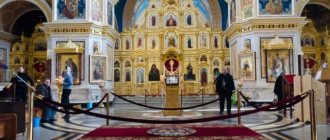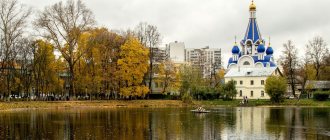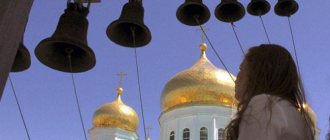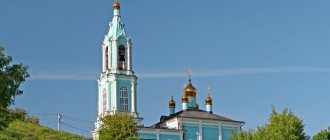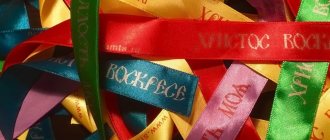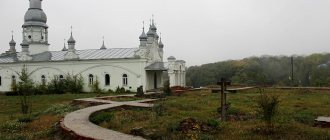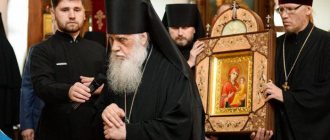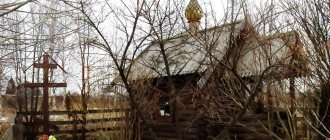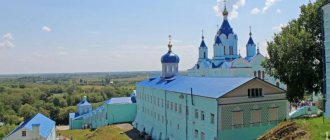Architecture
The stone single-domed temple was built in the traditional Russian style, similar to the Novgorod and Suzdal churches of the 16th century. The church is topped with an onion dome and reaches a height of 11 meters. The roof is made in turquoise color with a bronze patina. The outside walls are painted white, and the inside, according to Japanese taste, is lined with Japanese cedar. Wooden ceilings and a large Greek-style wooden ring chandelier complete the interior decoration. The temple has good acoustics. The iconostasis with images by John Chirot was moved from the former Annunciation Church.
LiveInternetLiveInternet
Quote from Olga-V's message
Read in full In your quotation book or community!
The churches are crowned with domes. Symbolism of domes in Orthodox churches
According to church symbolism, the dome indicates to Christians the need to strive from the earthly to the heavenly. Orthodox churches are built with an odd number of domes.
The number of heads of the temple reveals in numerical symbolism the hierarchy of the structure of the heavenly church. The different number of domes, or chapters, of a temple building is determined by who they are dedicated to. ONE-HEADED
The temple dome symbolizes the unity of God, the perfection of creation.
Single-domed churches were most often built in the pre-Mongol era and were a symbol of the One God and the perfection of creation (Church of the Intercession on the Nerl, Church of the Holy Spirit in the Trinity-Sergius Lavra, Demetrius Cathedral in Vladimir, Kazan Church).
Sometimes bell towers or chapels and two domes were attached to them, then they symbolized the two natures of the Lord Jesus Christ - Divine and human (Church of St. John the Climacus in the Moscow Kremlin).
The DOUBLE-DOMALED
temple, the two domes symbolize the two natures of the God-man Jesus Christ, the two areas of creation (angelic and human).
THREE-HEADED
the temple has three domes symbolizing the Holy Trinity
FOUR-HEADED
The temple's four domes symbolize the Four Gospels, the four cardinal directions.
The FIVE-DOMALED temple has five domes, one of which rises above the rest, symbolizing Christ as the Head of the Church and the four evangelists.
Five-domed churches became widespread in Rus', and their construction was carried out both in ancient times and in our days.
One of the domes, as a rule, rises above the others, which symbolizes Jesus Christ and the four evangelists.
Sometimes an initially five-domed cathedral after restructuring could turn into a six-domed one (St. Sophia Cathedral in Novgorod), however, just as it appeared from a previously three-domed cathedral. The reasons for such reconstructions were, as a rule, dilapidation and fire.
Five-domed churches have also been built recently, such as, for example, the Cathedral of Christ the Savior, recently revived in Moscow.
The seven-domed
temple, the seven domes symbolize the seven Sacraments of the church, the seven Ecumenical Councils, the seven virtues.
The NINE-DOMALED temple has nine domes associated with the image of the heavenly Church, consisting of nine orders of angels and nine orders of righteous people.
THIRTEEN-DOMATED temple thirteen domes symbolize Jesus Christ and the twelve apostles
24 DOMES - 12 prophets in the Old Testament and 12 apostles in the New Testament;
TWENTY FIVE
chapters can be a sign of an apocalyptic vision of the throne of the Holy Trinity and the twenty-four elders (Rev. 11, 15-18) or indicate praise to the Blessed Virgin Mary, depending on the dedication of the temple
or
12 prophets in the Old Testament and 12 apostles in the New Testament + Jesus Christ;
THIRTY-THREE CHAPTERS
- the number of earthly years of the Savior. The number of heads of temples is associated with the dedication of the main throne of the temple, and also often with the number of thrones connected in one volume.
photo from the Internet))
https://ru.wikipedia.org/
Series of messages “Esoterics of the spiritual world”:
Part 1 - tarot Part 2 - Photo that brings happiness... Part 40 - Angel of good silence... Part 41 - Cards of the fate of my family. Part 42 - Churches are crowned with domes. Symbolism of domes in Orthodox churches
Clergy
Abbots
- Okazaki abbots (1879 - 1890)
- Shizuoka abbot (1890 - 1894)
- Kyoto abbot (1894 - 1898)
- Toyoha abbot (January 1945 - 1949)
- Toyoha abbot (July - November 1957)
- Kyoto abbot (July 1973 - October 1974)
- Osaka abbot (1983 - 1986)
- Osaka and Kyoto abbots (July 12 (November 10) 2015 - April 1, 2016)
Priests
- Grigory Itoo (October 12, 2015 - April 1, 2016)
Deacons
- Jacob Hibi (September 3, 1949 - ?)
- Pavel Oikawa (1983 - November 1986)
- Grigory Itoo (June 17, 2012 - October 12, 2015)
Shrines
- The icon of the Crucifixion of the Lord with a particle of the tree of the Life-giving Cross of the Lord - a particle of the tree of the Holy Cross brought from Holy Mount Athos was given to the Nagoya parish of Fr. Christian Onea, rector of the Bucharest Church of Ceaus Radu, in June 2015 [11], after which it was inserted into the parish image of the Crucifixion that same summer
- Icon of the Great Martyr. George the Victorious with a particle of his relics - a particle of the relics of the saint brought from Holy Mount Athos was given to the Nagoya parish of Fr. Christian Onea, rector of the Bucharest Ceaus Radu Church, in June 2015 [11], after which it was inserted into the icon of the Georgian letter
- Icon of St. Nicholas of Japan with a particle of his relics - the icon was painted in Georgia, the relics were brought and solemnly placed in the icon at the celebration of the fifth anniversary of the new Epiphany Church of Metropolitan. Tokyo Daniil January 25, 2015
Why do churches need domes?
The domes of Orthodox churches as we know them now are purely a matter of tradition. In the sense that this is how it happened: churches should have domes. Moreover, it worked out exactly for us. In Orthodox Greece, for example, many churches are built without the usual domes.
Here, for example, is a church on the island of Corfu: typical Orthodox Greek architecture.
Like this temple: also Greece
Then what do domes actually mean for a temple if they are not built everywhere, and why does the temple need them?
Initially, a dome is just one type of vault that a building can have. For example, this design would be ideal to enclose large spaces when supporting columns need to be avoided. This type of overlap has been known since ancient times. Even before Christianity, domes were erected in buildings of worship and importance for the state - in short, where a large number of people gathered to celebrate something or perform a religious ceremony.
Over time, domes began to be directly associated with “sacred” buildings. In the Christian tradition, the domed vault immediately began to symbolize the heavenly world, eternity, and the universe. Moreover, symbolism almost immediately became the main side of the dome, since in most temples (in those countries and cultures where it was used) the dome did not and does not have a constructive meaning and was simply the “crowning” of the structure.
Look: Hagia Sophia in Constantinople (now a mosque). It was built as an Orthodox church in the 6th century, but retained the “original” approach to the dome - as a full-fledged vault.
And here is the temple in Barashi, Moscow. The dome is small, “symbolic”. The role of the vault is played by the roof-slab.
The fact that the dome can play a “symbolic” rather than constructive role has developed historically. For example, in Rus': the first churches themselves were almost all wooden and were made using the classic log house technique, so covering them with large domes was structurally illogical and impractical. The dome no longer played the role of a “roof”, but simply rose above the temple. Therefore, it is more correct to call them not domes, but chapters or “domes.”
This is not an ancient temple, but a modern one: in the village of Verbilki near Moscow, but it well illustrates what has been said about the domes of wooden churches:
And here is an example of a temple design where the dome, on the contrary, actually plays a constructive role. Moscow. Church of the Assumption of the Blessed Virgin Mary near Prechistenka. The dome covers the entire chapel, although there is still a small turret above it, which is crowned with an “onion”.
Or the Church of St. Michael the Archangel in Kubinka near Moscow. Also: a large dome-shaped vault and a smaller “onion” above it.
Or the main cathedral of the St. John the Baptist Monastery in Moscow. Not the most clearly expressed example, perhaps, but nevertheless:
Domes have truly become an integral part of Russian tradition. Moreover, our domes are characterized by the “onion” shape. Some see this as a reminder of a burning candle. Maybe. But initially, such symbolism was not included in the onion-like shape of the dome - it was simply about a beautiful form that would harmoniously complete the image of the temple.
Moscow Compound of the Holy Trinity Sergius Lavra in Moscow
Documents, literature
- Diaries of St. Nicholas of Japan.
- Diaries of Fr. Petra Shibayama, collection of Andrey Shibayama Masao.
- “Seikyo Jihoo” (“Orthodox Messenger” - 『正教時報』), No. 2-19, 1913.10.05, p. 39.
- “Pandane” (“Yeast” - 『ぱんだね』), No. 5-8, 1926.05; No. 7-7, 1928.04, p. 11-17; No. 7-11, 1928.08, p. 16-21; No. 7-12, 1928.09, p. 9-15; No. 10-9, 1931.06, p. 11-15; No. 10-10, 1931.07, p. 1-14; No. 10-11, 1931.08, p. 19-23; No. 11-4, 1932.01; No. 15-11, 1935.08, p. 1.
- Nagoya Ward Bulletin:
- “Nagoya seikyo-kai-hoo” (“Bulletin of the Nagoya Orthodox Church” - 『名古屋正教会報』), No. 75, 1970.09.
- “Kohitsuji mure” (“Sheep Flock” - 『仔羊群』), No. 78, 1972.12.
- “Ten no fue” (“Trumpet of Heaven” - 『天の笛』), No. 23, 1986.10; No. 32, 1987.08; No. 41, 1988.07.
Number, shape and color of domes on temples
Types of Orthodox churches
There are several types of temple buildings, depending on the shape of the foundation, each of which has its own symbolic meaning.
The Temple of God differs in appearance from other buildings. For the most part, the temple at its base is arranged in the form of a cross.
This means that the temple is dedicated to the Lord crucified on the cross for us and that through the cross the Lord Jesus Christ delivered us from the power of the devil.
Often the temple is built in the form of an oblong ship
, this means that the Church, like a ship, in the image of Noah’s Ark, leads us along the sea of life to a quiet harbor in the Kingdom of Heaven.
Sometimes the temple is arranged in the form of a circle
, this reminds us of the eternity of the Church of Christ.
The temple can also be built in the form of an octagon
, like
a star
, meaning that the Church, like a guiding star, shines in this world.
At the entrance to the temple, a porch (platform, porch) is arranged outside. Inside the temple is divided into three parts: 1) vestibule
the temple
itself , or
the middle part of the temple
, where the worshipers stand, 3)
the altar
, where the clergy perform services and the most important place in the entire temple is located -
the holy altar
, on which the sacrament of Holy Communion is performed.
Altar
separated from the middle part of the temple
by an iconostasis
, consisting of several rows
of icons
and having three gates;
the middle gate is called royal
because through them the Lord Jesus Christ Himself, the King of glory, invisibly passes in the Holy Gifts (in Holy Communion). Therefore, no one is allowed to pass through the royal doors except the clergy.
Performed according to a special rite (order) in a temple, led by a clergyman, the reading and singing of prayers is called a divine service.
Altar and liturgical accessories
The most important part of the temple is the altar
.
In the altar, Divine services are performed by the clergy and the most sacred place in the entire temple is located - the holy altar
, on which the sacrament of Holy Communion is performed. The altar is placed on a raised platform. It is higher than other parts of the temple, so that everyone can hear the Divine service and see what is happening in the altar. The very word “altar” means an elevated altar.
At the entrance to the temple, a porch (platform, porch) is arranged outside. Inside the temple is divided into three parts: 1) vestibule
the temple
itself , or
the middle part of the temple
, where the worshipers stand, 3)
the altar
, where the clergy perform services and the most important place in the entire temple is located -
the holy altar
, on which the sacrament of Holy Communion is performed.
1.Apse.
A ledge on the eastern side of the temple, as if attached to it. Most often it has a semicircular shape. The altar is located in the apse.
2.Cube
.
The main part of the temple.
3.Zakomara _
.
Features of Russian temple architecture.
Semicircular or keel-shaped completion of part of the outer wall of the temple. 4. Drum.
The upper part of the temple, over which a dome is built, ending with a cross. As a rule, drums have the shape of a cylinder or polyhedron.
5.Dome.
A head with a drum and a cross, crowning the temple. Most often in the Russian tradition, the dome has the shape of an onion. The number of domes may be different, but each of them has its own meaning: two domes mean two natures in Jesus Christ - Divine and human, three - three Persons of the Holy Trinity, five - Jesus Christ and the four Evangelists, seven - seven Sacraments and seven Ecumenical Councils , nine - nine ranks of angels, thirteen - Jesus Christ and twelve apostles. Rarely, but there are more domes.
6.Bell tower
.
A special high extension to the temple (usually above the vestibule), at the top of which there is a belfry.
7. Portal
.
Architecturally designed entrance to the temple.
8. Porch with porch
.
An open or closed porch in front of the entrance to the temple, elevated relative to ground level.
Domes.
Dome
(Italian Cupola - dome, vault, from Latin cupula, diminutive of cupa - barrel) - a spatial, load-bearing covering structure, in shape close to a hemisphere or other surface of rotation of a curve.
The main thing in the temple is the dome. They receive special attention and treatment. The dome can be of different shapes, colors, and have a different number of chapters. All characteristics have their own symbolic meaning.
DOME SHAPE
Helmet-shaped
coverings most often refer to a specific form of dome coverings, close to the shape of an ancient Russian helmet. The helmet shape is a symbol of warfare, the spiritual battle waged by the Church against the forces of evil and darkness.
Onion dome
has a convex shape, smoothly tapering at the top, similar to an onion. Most often, such domes are used in Russia, Turkey, India and the Middle East. The shape of the onion is a symbol of the candle flame, the victory of the forces of light.
Umbrella domes
divided into segments by ribs radiating from the center to the base of the dome.
Tent.
In architecture, a tent is the end of towers and temples in the form of a tetrahedral or octagonal pyramid. A new page in the history of medieval Russian architecture Liberation from the Horde yoke stimulated a new upsurge in architecture. By this time, another national type of temple had emerged. The typical Byzantine dome system was transformed into a pointed tower top
The color of the dome is also important in the symbolism of the temple
.
Gold
- a symbol of heavenly glory. The main churches and churches dedicated to Christ and the Twelve Feasts had golden domes. Gilding of domes is a purely Orthodox tradition that is not found among other faiths. This apparent extravagance has its own unbreakable logic. For an Orthodox person, gold is primarily a symbol of eternity, incorruptibility, royalty and heavenly glory. It is not for nothing that one of the gifts brought by the Magi to the baby Jesus was gold. In Rus', the heads of the main temples, as well as temples dedicated to the Savior, were covered with gold.
Blue domes with stars
crowned churches dedicated to the Mother of God, because the star recalls the birth of Christ from the Virgin Mary.
Trinity churches had green domes
because
green is the color of the Holy Spirit.
Temples dedicated to saints are also crowned with green
or
silver domes.
In monasteries there are black domes
- this is the color of monasticism.
The altar is separated from the middle part of the temple by an iconostasis
, consisting of several rows
of icons
and having three gates;
the middle gate is called royal
because through them the Lord Jesus Christ Himself, the King of glory, invisibly passes in the Holy Gifts (in Holy Communion). Therefore, no one is allowed to pass through the royal doors except the clergy.
Dome shape
also has a symbolic meaning.
- The helmet-like shape was reminiscent of the army, of the spiritual battle waged by the Church with the forces of evil and darkness.
- The shape of the onion is a symbol of the candle flame, turning us to the words of Christ: “You are the light of the world.”
· The dome is a symbol of the heavenly (sphere) and eternal (circle)
Helmet-shaped
the form was reminiscent of the army, of the spiritual battle waged by the Church against the forces of evil and darkness.
The tradition of constructing one or more domes over the main building of the temple came to us from Byzantium.
Number, shape and color of domes on temples
The number of domes on temples is symbolic:
• Single-domed temple:
the dome symbolizes the unity of God, the perfection of creation.
• Double-domed temple:
the two domes symbolize the two natures of the God-man Jesus Christ, the two areas of creation (angelic and human).
• Three-domed temple:
the three domes symbolize the Holy Trinity.
• Four-domed temple:
the four domes symbolize the Four Gospels, the four cardinal directions.
• Five-domed temple:
five domes, one of which rises above the others, symbolize Jesus Christ and the four evangelists.
• Seven Domed Temple:
seven domes symbolize the seven Sacraments of the Church, seven Ecumenical Councils, seven virtues.
• Nine-domed temple:
nine domes symbolize the nine ranks of angels.
• Thirteen-domed temple:
thirteen domes symbolize Jesus Christ and the twelve apostles.
• Twenty-five chapters
may be a sign of an apocalyptic vision of the throne of the Holy Trinity and the twenty-four elders (Rev. 11, 15-18) or denote praise to the Blessed Virgin Mary, depending on the dedication of the temple.
• Thirty-three chapters
- the number of earthly years of the Savior.
